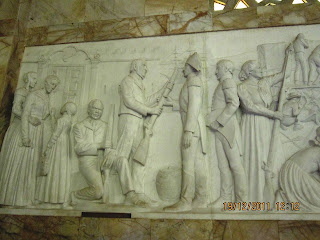As South Africans, as Afrikaners (Afrikaans speaking South Africans) we felt it our duty to visit this monument. Built in loving memory of the greatest of all expeditions. The Great Trek.
Physically, the Voortrekker Monument is 40 metres high, with a base of 40 metres by 40 metres. The building has strong architectural resemblance to German monuments, in particular the Völkerschlachtdenkmal in Leipzig.
The Voortrekker Monument is not a fancy structure, it does not have huge fresco's or elaborate decorations. It represents exactly the afrikaner people. We are strong, practical and to the point. We are proud and hard working. We have suffered many setbacks but we have survived, prospered even. Through the years we played our part in shaping this country.
At the foot of the Monument stands Anton van Wouw's bronze sculpture of a Voortrekker woman and her two children, paying homage to the strength and courage of the Voortrekker women.
The huge granite structure is guarded by the 4 pillars of the Great Trek. Four men who lead the boers, men who not only acted as path finders but proved themselves as war hero's. Their faith in God guided them and kept the members of their trek safe. They showed courage in the face of adversity. These men will always be remembered as hero's.
When you enter though the doors of the monument you are surrounded by a carved pictorial. Telling the story of the Great Trek. From the hall of hero's you can go up the stairs to the very top of the dome or for the faint of heart you can go up just a few stories and walk around to the viewing deck. The rugged architecture of the building is quite impressive. The views from here is great. We could even make out the Union Buildings in the far distance.
Visiting the Voortrekker monument made me feel like a pilgrim. I strongly feel that it is a must for every Afrikaans speaking South African to visit this place. To honour and remember those brave people who came before us and shaped our country.
Ringing out from our blue heavens
From our deep seas breaking ground
Over ever lasting mountains, where the echoing grace resounds
From a place where creaky wagons, cut their trails into the earth
Calls the spirit of our country of the land that gave us birth!
At thy call we shall not falter,
Firm and steadfast we shall stand,
At thy will we live or perish
O' South Africa
dear Land































































